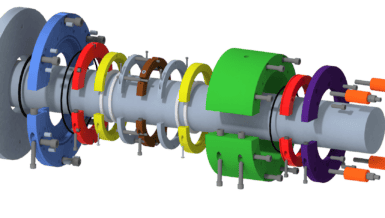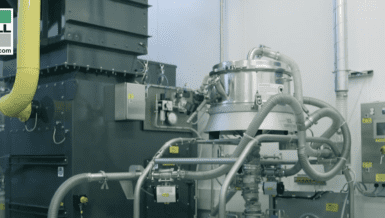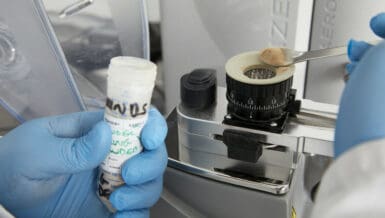This includes the meticulous management of powders, a pivotal element in battery production, as they are vital for crafting battery electrodes. Handling these powders involves a delicate equilibrium, balancing the imperatives of purity, contamination prevention, and preserving their essential physical and chemical attributes.
Moreover, the surge in electric mobility and the ever-growing demand for energy storage solutions have catapulted the need for raw materials like lithium, cobalt, nickel, and manganese, particularly within the sphere of battery manufacturing. Within the rigorous battery production chain, the supply of raw materials takes precedence as the initial and fundamental stride, fundamentally impacting the ultimate quality of the end product. Once more, the pivotal role of powder handling comes to the forefront, influencing both the longevity and performance of batteries. This entails measures for explosion protection and careful consideration of containment aspects to ensure the integrity and safety of the entire battery production process.
Challenges faced when handling battery powders
Handling battery powders presents an array of intricate challenges for process engineers, as these powders are fundamental to producing advanced energy storage systems. These challenges stem from battery powders’ unique physical and chemical properties and the rigorous demands of modern energy storage technologies.
- Material Characteristics: Battery powders often exhibit complex properties, including fine particle sizes, irregular shapes, and sensitivity to moisture. Understanding and controlling these characteristics is essential to ensuring consistent quality in battery production.
- Powder Flowability: Ensuring the smooth flow of powders during handling and processing is critical. Poor flowability can lead to production bottlenecks and inconsistencies in electrode manufacturing.
- Contamination Control: Maintaining the purity of battery powders is paramount, as even trace contaminants can significantly impact battery performance. Effective containment and isolation strategies are vital to prevent cross-contamination.
- Explosion Risks: Some battery powders, particularly those containing lithium, pose explosion risks if mishandled. Engineers must implement robust safety measures, such as inert atmospheres or explosion-proof equipment, to mitigate these risks.
- Process Efficiency: Achieving high process efficiency while handling powders is a constant challenge. Engineers must optimize equipment design, minimize powder loss, and reduce energy consumption to enhance production efficiency.
- Environmental Considerations: Battery production is under increasing scrutiny for its environmental impact. Engineers must work towards sustainable solutions for handling and disposing of battery powders to meet stringent environmental regulations.
To address these challenges, process engineers engage in ongoing research and development, leveraging advanced technologies and methodologies to enhance the precision and efficiency of battery powder handling, ultimately driving the evolution of energy storage solutions.
Manufacturing of battery masses
Manufacturing battery masses is a complex and pivotal process, primarily focusing on the meticulous handling and processing of battery powders. Battery masses, or electrode materials, form the core of energy storage technologies, and their quality directly impacts battery performance and longevity.
Battery powder handling begins with procuring and storing essential materials like lithium, cobalt, nickel, manganese, and graphite. These materials often exist in powdered forms, requiring specialized equipment and techniques to transport and store them while preserving their purity. Precision in weighing and mixing these powders is critical, as the formulation of the battery mass influences its electrochemical properties.
Subsequently, the powders are processed into electrode sheets through calendaring and coating, demanding precision and consistency. Contamination control is paramount, and engineers must carefully design manufacturing environments to minimize the risk of impurities.
The complexity of battery powder handling and processing underscores the critical role that process engineers play in developing advanced energy storage solutions, driving innovations that shape the future of batteries and sustainable energy technologies.
Innovations in battery powder processing
The latest innovations in battery powder processing are revolutionizing energy storage technology. One notable advancement involves the development of solid-state batteries, which replace traditional liquid electrolytes with solid materials, enhancing safety and energy density. Cutting-edge powder processing techniques, such as spray drying and high-energy ball milling, are employed to fabricate nanostructured cathode and anode materials. These processes enable precise control over particle size and composition, resulting in batteries with improved performance and longer lifespans.
Moreover, innovations in recycling and repurposing battery powders are addressing sustainability concerns. Techniques like direct recycling and upcycling are gaining prominence, allowing the reuse of battery materials, thus reducing waste and environmental impact. These breakthroughs in battery powder processing promise to transform industries, from electric vehicles to renewable energy storage, by providing safer, more efficient, and environmentally responsible energy solutions.
Battery recycling process
Battery production is a complex procedure, and recycling plays a pivotal role in mitigating the environmental impact of hazardous chemicals. Nonetheless, battery recycling encounters several challenges. Carbon black, a substance with dual utility and inhalation risks, poses a significant concern due to its fine particles that can lead to respiratory issues. Therefore, stringent safety measures are necessary when handling carbon black.
The recycling of carbon black from used batteries primarily involves a process known as pyrolysis, which entails the thermal decomposition of organic materials within an oxygen-free environment. Batteries are initially disassembled and mechanically crushed into their constituent components. Subsequently, these battery elements undergo heating in an oxygen-free oven. This thermal treatment breaks down the organic materials, yielding a mixture of liquid and gaseous substances and carbon black. The resultant blend undergoes several refining steps to isolate and purify the carbon black from other constituents.
The reclaimed carbon black finds applications in various sectors, including rubber and plastic manufacturing, or it can be reintegrated into battery production. Battery recycling also recovers other materials like lithium, cobalt, nickel, and carrier foils made of copper or aluminum.










































